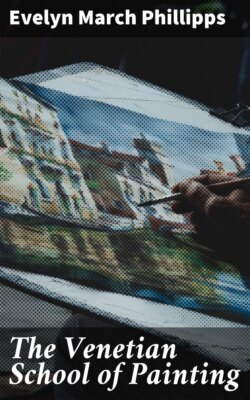Читать книгу The Venetian School of Painting - Evelyn March Phillipps - Страница 11
На сайте Литреса книга снята с продажи.
CHAPTER IV
ОглавлениеTable of Contents
THE SCHOOL OF MURANO
The important little town of Murano, a satellite of Venice, lies upon an island, some ten minutes’ row from the mother State, distinct from which it preserved separate interests and regulations. Its glass manufacture was safeguarded by the most stringent decrees, which forbade members of the Guild to leave the islet under pain of death. Its mosaics, stone work, and architecture speak of an early artistic existence, and we recognise the justice of the claim of Muranese painters to be the first to strike out into a more emancipated type than that of the primitives. The painter Giovanni of Murano, called Giovanni Alemanus or d’ Alemagna, names between which Venetian jealousy for a time drew an imaginary distinction, had certainly received his early education in Germany, and betrays it by his heavier ornamentation and more Gothic style; but he was a fellow-worker with Antonio of Murano, the founder of the great Vivarini family, and the Academy contains several large altarpieces in which they collaborated. “Christ and the Virgin in Glory” was painted for a church in Venice in 1440, and has an inscription with both names on a banderol across the foreground. The Eternal Father, with His hands on the shoulders of the Mother and Son, makes a group of which we find the origin in Gentile da Fabriano’s altarpiece in the Brera, and it is probable that one if not both masters had been studying with the Umbrian and absorbing the principles he had brought to Venice. It is easy to trace the influence of Giovanni d’ Alemagna, though not always easy to pick out which part of a picture belongs to him and which to Antonio working under his influence. In S. Pantaleone is a “Coronation of the Virgin,” with Gothic ornaments such as are not found in purely Italian art at this period, but the example in which both masters can be most closely followed is the great picture in the Academy, the “Madonna enthroned,” where she sits under a baldaquin surrounded by saints. Here the Gothic surroundings become very florid, and have a gingerbread-cake effect, which Italian taste would hardly have tolerated. Many features are characteristic of the German; the huge crown worn by the Mother, the floriated ornament of the quadrangle, the almost baroque appearance of the throne. Through it all, heavily repainted as it is, shines the dawn of the tender expression which came into Venetian art with Gentile.
Antonio da Murano. ADORATION OF THE MAGI. Berlin. (Photo, Hanfstängl.)
Giovanni d’ Alemagna and Antonio da Murano were no doubt widely employed, and when the former died Antonio founded and carried on a real school in Venice. In 1446 he was living in the parish of S. Maria Formosa with his wife, who was the daughter of a fruit merchant, and the wills of both are still preserved in the parish archives. Gentile da Fabriano had set the example for gorgeous processions with gay dresses and strange animals; winding paths in the background and foreshortened limbs prove that attention had been drawn to Paolo Uccello’s studies in perspective, while many figures and horses recall Pisanello. A striking proof of the sojourn of Gentile and Pisanello in Venice is found in an “Adoration of Magi,” now ascribed to Antonio da Murano, in which the central group, the oldest king kissing the Child’s foot, is very like that in Gentile’s “Adoration,” but the foreshortened horses and the attendants argue the painter’s knowledge of Pisanello’s work. A comparison of the architecture in the background with that in the “St. George” in S. Anastasia shows the same derivation, and the dainty cavalier, who holds a flag and is in attendance on the youngest king, is reminiscent of St. George and St. Eustace in Pisanello’s paintings in the National Gallery, so that in this one picture the influences of the two artists are combined.
Antonio took his younger brother, Bartolommeo, into partnership, and the title of da Murano was presently dropped for the more modern designation of Vivarini. Both brothers are fine and delicate in work, but from the outset of their collaboration the younger man is more advanced and more full of the spirit of the innovator. In his altarpiece in the first hall of the Academy the Nativity has already a new realism; Joseph leans his head upon his hand, crushing up his cheek. The saints are particularly vivid in expression, especially the old hermit holding the bell, whose face is brimming with ardent feeling.
PRINCIPAL WORKS
Giovanni d’ Alemanus and Antonio da Murano.
| Venice. | Christ and the Virgin in Glory; Virgin enthroned, with Saints. |
Antonio da Murano.
| Berlin. | Adoration of Magi. |
